This is my absolute FAVORITE, tried and true recipe for silky smooth, incredibly rich and creamy Pastry Cream.
This pastry cream is simple to make, remarkably stable, and comes out perfect every time. It's rich and thick enough to use as a filling for cream pies, layer cakes and layered pastries like the classic Napoleon dessert.
It's also creamy enough to easily pipe into pastries like eclairs and cream puffs.
Thanks to a bit of gelatin, this pastry cream will hold its own at room temperature for hours without breaking down, can be used inside baked pastries like hand pies, and can even be frozen.
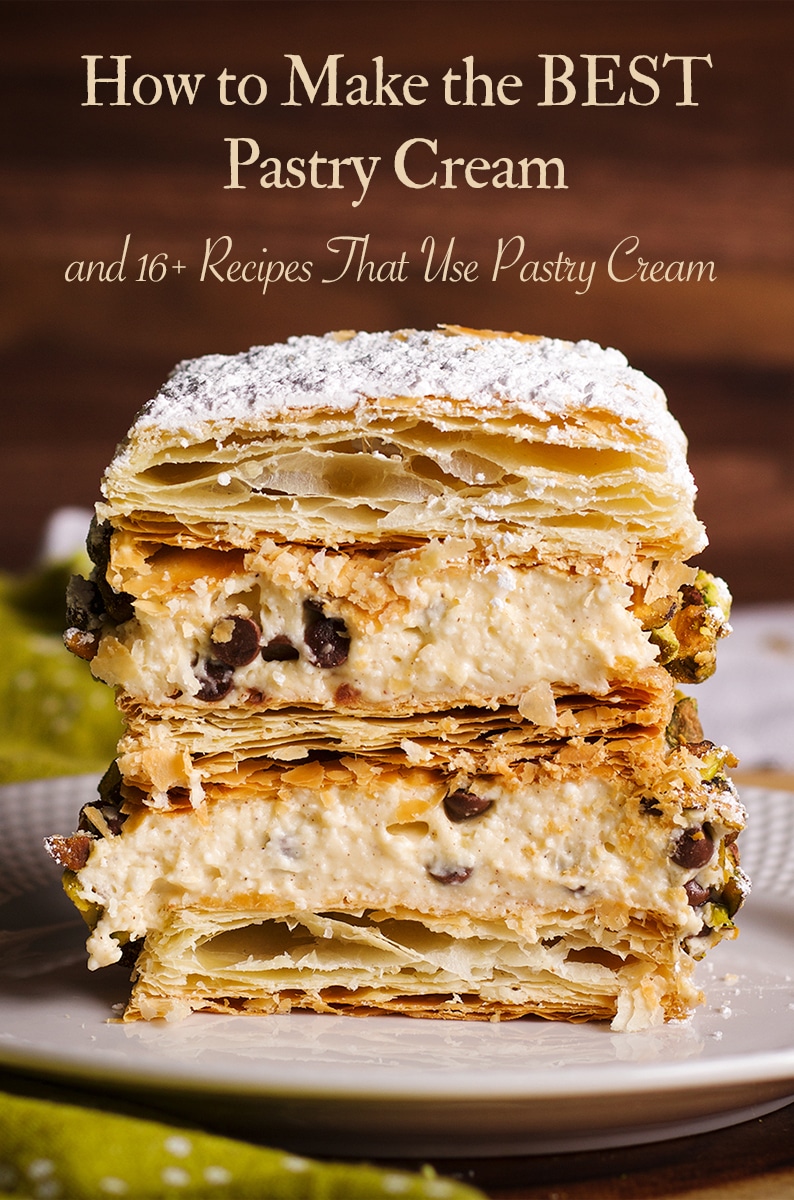
"This is my first time trying this recipe and it came out perfect. I followed it step by step, read over it multiple times before attempting it. I have tried making Napoleons before and failed miserably, but this time they were a success. Thanks for the great recipe. I am always trying to impress my husband and his family with my baking skills and now I have one more recipe in my arsenal." - Pam
Jump to:
- What is Pastry Cream?
- What's the difference between pastry cream and custard?
- Ingredients Needed to Prepare this Recipe
- How to Make Pastry Cream {and avoid some common problems}
- The Surprising Secret Ingredient that Solves Many Pastry Cream Challenges
- Can Pastry Cream Be Used in Baked Pastries?
- Can you Freeze Pastry Cream?
- 16 Recipes that Use Pastry Cream
- 📖 Recipe
- 💬 Comments

+ Subscribe to my newsletter for new and exclusive recipes in your in-box every month! As a full time traveler, living, working, cooking, and baking from a 5th wheel RV, it's also where I share our experiences of life on the road.
What is Pastry Cream?
Pastry cream is a custard made with eggs, milk, sugar, and starch, that's thick enough to be used in a wide variety of pastries and desserts. And, there are few pastries in this world that really good pastry cream can't make even better.
Good pastry cream is silky smooth, flavorful, and more rich than sweet. It should be thick enough to hold its own between layers of cake or flaky pastry, or when pipped into doughnuts or spread into a tart or pie shell.
What's the difference between pastry cream and custard?
I feel like this is a tricky question that may have more to do with the area and culture in which you grew up than any sort of "technical" differentiation.
But, essentially, the word "custard" is used to describe any kind of dessert or dessert sauce that is thickened with eggs. Think of it as more as a broad category than any kind of specific food.
For example, here's a short list of dessert custards we all know and love:
Custard Sauces
Custard sauces, like the kind typically poured over Irish Apple Cake, or the crème anglaise spooned over a rich Chocolate Soufflé, are quite thin and somewhat similar to the consistency of melted vanilla ice cream.
For that matter, many kinds of ice cream are technically custard desserts as well. Frozen custard style ice cream, and Italian Gelato, begin with a custard base that is essentially the same thing as crème anglaise.
Oven baked custards
Oven baked custards like Mexican Flan, Pots de Creme, Creme Brûlée, or Crustless Custard Tart are thick enough to be cut with a knife, while starch-thickened custards are similar in consistency to pudding.
What's the difference between Crème Pâtissière and American-style puddings?
Crème Pâtissière and American-style puddings are both starch-thickened custards made from a simple mixture of milk, eggs, sugar, and flour or cornstarch.
So, there isn't actually a difference between pastry cream and custard. Pastry Cream IS a kind of custard.
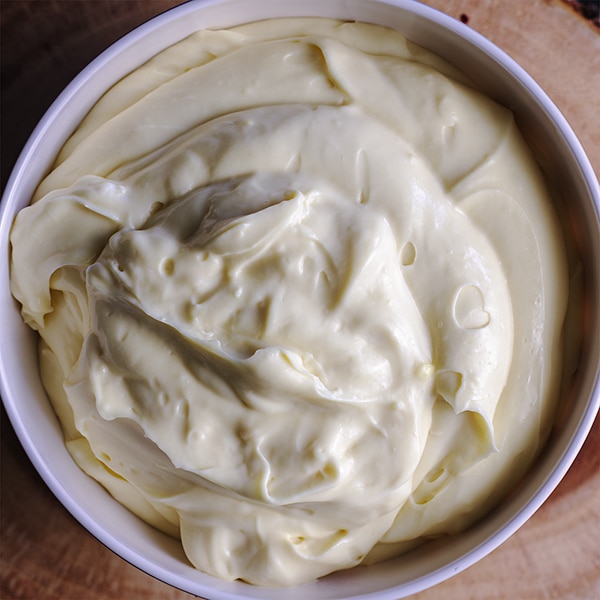
"My favourite recipe for pastry cream -- always yields a delicious and flavorful cream to use in cream puffs and cakes!" - Michelle
Ingredients Needed to Prepare this Recipe
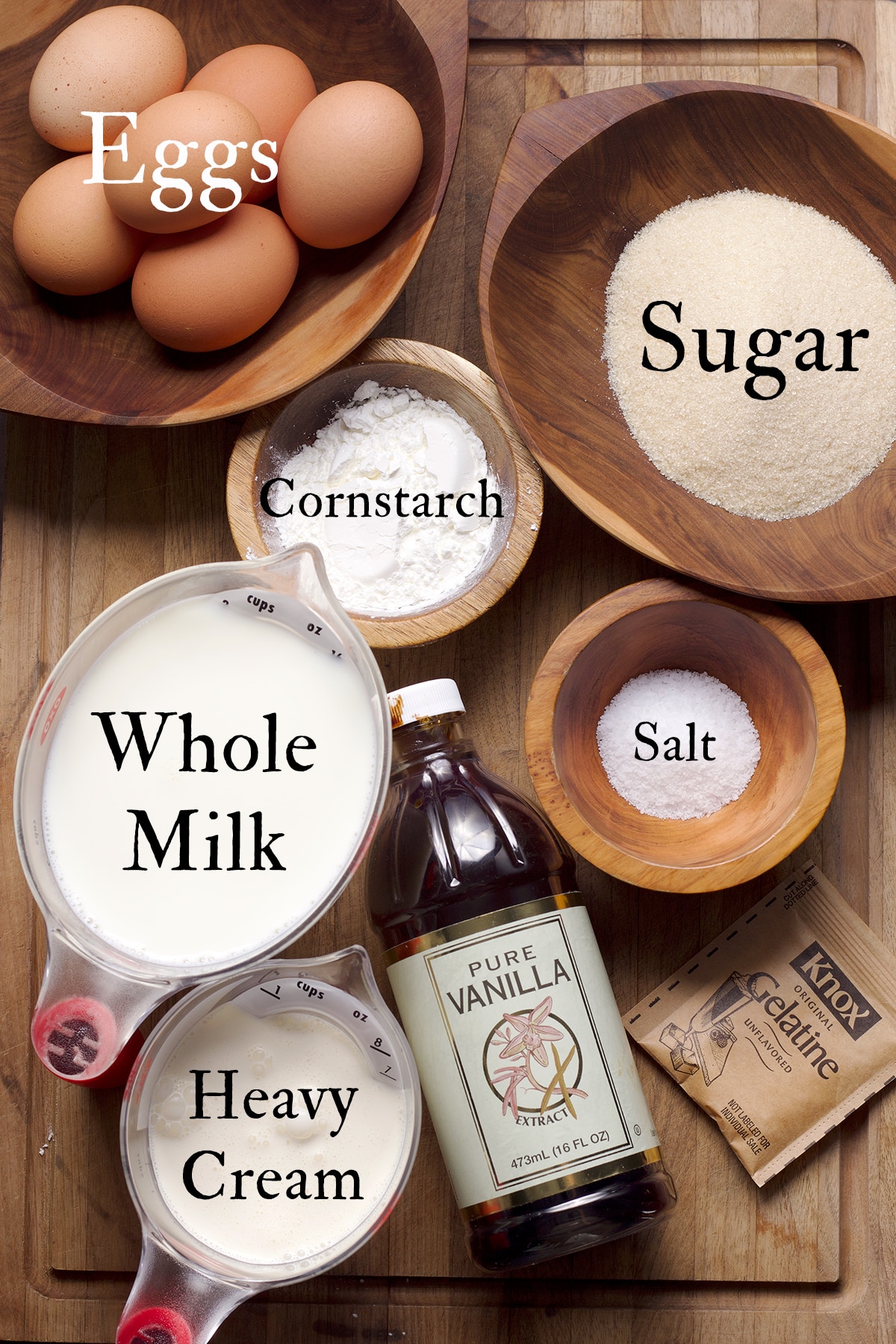
- Unflavored gelatin. Just 1 ½ teaspoons of unflavored gelatin is the secret weapon in this recipe because it creates pastry cream that is incredibly stable. (More about what gelatin does for pastry cream below.)
- 6 large egg yolks. Egg yolks create a super rich and creamy pastry cream. Check out the notes section in the recipe card for ideas about what to do with the egg whites.
- Cornstarch. This recipe uses cornstarch to thicken the custard.
- Whole milk. You can, in a pinch, use 2% milk, but I don't recommend using skim milk in this recipe. The little bit of extra fat in whole milk creates a richer consistency in the pastry cream.
- Granulated sugar. This recipe calls for just ½ cup of sugar, which is the perfect amount for pastry cream that's sweet, but not cloying.
- Salt. Just ¼ teaspoon of salt brings out the flavors of the other ingredients.
- Pure vanilla extract. Avoid imitation vanilla in this recipe because it can leave an unpleasant aftertaste.
- Heavy whipping cream. A bit of whipped cream, folded into the pastry cream right before using creates a light and fluffy consistency.
How to Make Pastry Cream {and avoid some common problems}
In general, starch thickened custards like Pastry Cream rely on cornstarch or flour to create a thick, rich, pudding-like texture that can hold its own when used as a filling for a wide varieties of pastries and desserts.
Not only are starch-thickened custards thicker than custard sauces like crème anglaise, they are also more stable. This is because starch slows down protein coagulation, making the eggs more resistant to curdling.
Even still, there are three common pastry cream problems I wanted to overcome with this recipe:
- Pastry cream can become unstable and "break" (separate) if it gets too cold or sits out at room temperature for too long.
- Pastry cream has a tendency to curdle when baked inside a pastry.
- It's challenging to add enough thickener (cornstarch or flour) to pastry cream in order to create a pipe-able consistency that will hold its shape and not squeeze out from between the layers of cakes or pastries without ending up with a chalky texture and starchy taste.
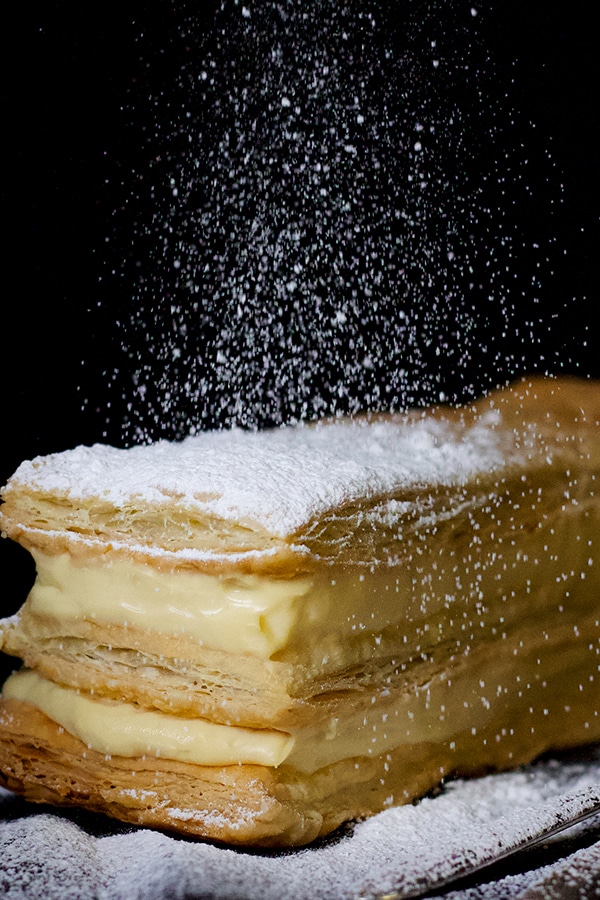
The Surprising Secret Ingredient that Solves Many Pastry Cream Challenges
A little bit of gelatin added to pastry cream after cooking is the solution to so many difficulties with this custard.
The addition of gelatin creates a pastry cream that's thick and sturdy enough to hold up between layers of a flaky Napoleon, as a filling for a layer cake, or piped into chocolate eclairs, cream puffs (profiteroles) or banana cream cake.
Even better, gelatin will remain stable at room temperature and does not curdle when baked. 🙌
So, for example, you can confidently fill a wedding, birthday, or anniversary cake with pastry cream, even if you know it will need to sit out at room temperature for several hours, and NOT worry about the filling breaking down and turning to liquid mush inside your cake.
Or, as I have done many times, confidently serve lovely little amaretto custard and fruit tarts at a brunch open house, placing them on the serving table at 9am and know that they will still be perfectly sliceable at noon.
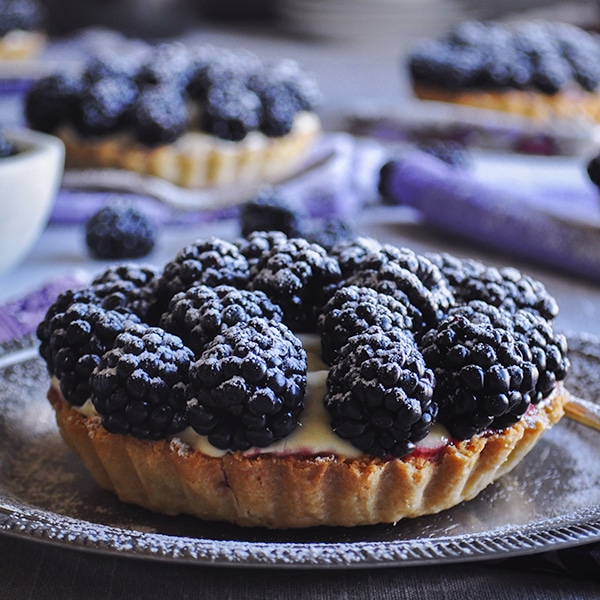
Can Pastry Cream Be Used in Baked Pastries?
Gelatin makes it possible to include crème pâtissière in baked desserts.
Say what??? Yes, it's true. Two of my favorite desserts of all time are filled with pastry cream BEFORE you bake them:
- Strawberries and Cream Pie includes a thick layer of pastry cream topped with fresh strawberry pie filling inside a flaky double pie crust. It's bright, and creamy, and absolutely screams summer and picnics and sunshine.
- Apple Butter and Pastry Cream Hand Pies. These buttery little hand pies are filled with almond pastry cream and apple butter. They are flaky, creamy, & packed with warm apple flavor.
For both of these desserts, I have received emails from skeptical bakers asking if I'm sure the pastry cream should be added before baking. It's a good question because usually the answer would be no.
In this case, thanks to the awesome properties of gelatin, the answer is YES! Try it. You'll see.
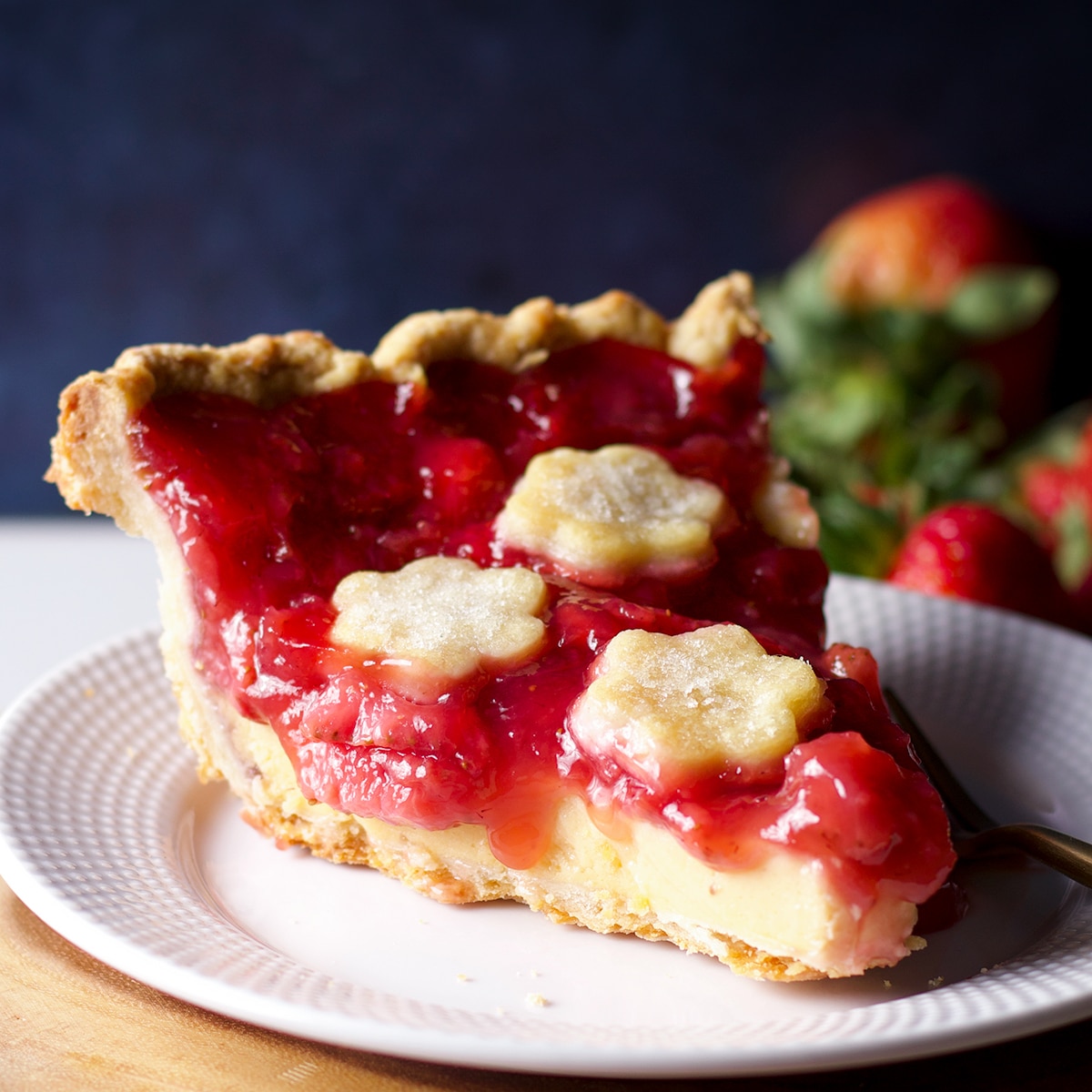
How to use pastry cream in baked pastries:
If you are going to use this pastry cream in a pastry or dessert that will be baked after filling, do NOT add the whipped cream.
This recipe instructs you to chill the cooked custard in the refrigerator for about three hours then beat in some whipped cream. The whipped cream lightens the pastry cream, giving it a lovely, airy texture, without interfering with it's sturdy, rich structure.
However, if you are going to use this pastry cream to fill a pie, or any other pastry that will be baked, it's important to leave out the addition of the whipped cream which could "melt" while baking.
Can you Freeze Pastry Cream?
According to the entire internet, you cannot freeze pastry cream. But, friends, I am here to tell you that you CAN, in fact, freeze this pastry cream because of one superstar ingredient: gelatin.
Yes, the recipe also includes cornstarch and freezing things thickened with cornstarch generally results in a gloppy, gluey mess. But, simply add some gelatin and you can freeze the pastry cream with abandon.
The consistency after it has thawed will still be perfectly creamy and delicious. It's magical. Here's how to freeze it:
- Freeze the filling BEFORE adding the whipped cream. Let the pastry cream cool in the refrigerator completely. Then, make sure it's in an air-tight container or a bowl that's well wrapped and put it in the freezer for up to 3 months.
- Allow the frozen pastry cream to thaw in the refrigerator overnight or at room temperature for about 3-4 hours. Once thawed, add the pastry cream to whipped cream as instructed in steps 10 and 11 of this recipe.
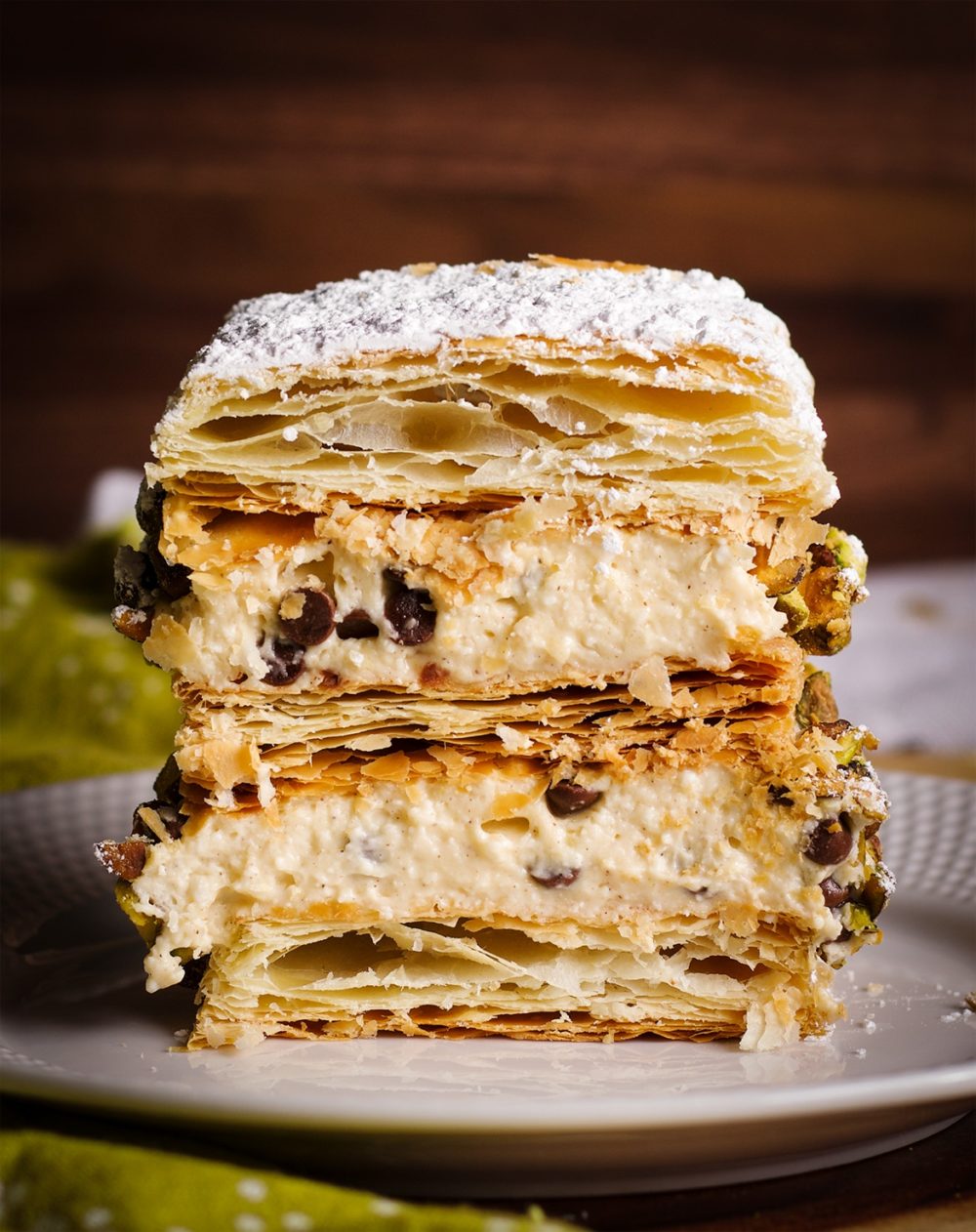
16 Recipes that Use Pastry Cream
- The Classic French Napoleon: The classic Napoleon Dessert (mille-feuille) includes flaky puff pastry layered with creamy vanilla pastry cream. It's one of those classic French pastries that exemplifies everything I love about French pastry - It's elegantly simple and deliciously indulgent.
- Cannoli Napoleon: This Cannoli Napoleon marries two delicious desserts, the Italian Cannoli and the French Napoleon, into one delicious, flaky, creamy pastry.
- Coconut Cream Cake: This coconut cake is light, tender, and exceptionally soft and fluffy. Filled with a super thick layer of coconut cream and covered in coconut buttercream, every bite is so rich and creamy it practically melts in your mouth.
- Extra Creamy Coconut Cream Pie: This Coconut Cream Pie, with its rich cream filling and buttery toasted almond crust, is the ultimate coconut lover's indulgence.
- Easy Homemade Doughnuts: This doughnut recipe can be used to make pretty much any kind of homemade doughnut you can imagine, including cream filled.
- Doughnut Holes Filled with Salted Caramel Pastry Cream: Tender yeast raised doughnut holes are filled with salted caramel pastry cream and drizzled with salted caramel sauce.
- Profiteroles {Cream Puffs}: Profiteroles (cream puffs) are buttery little balls of choux pastry (pâte à choux) baked until light, tender, and puffed up to form a hollow center. They are the perfect vessel for pastry cream, ice cream, whipped cream, all varieties of savory ingredients, or anything your imagination and taste buds, can dream up.
- Pasty Cream Filled Chocolate Eclairs: Eclairs are buttery logs of choux pastry (pâte à choux) baked until light, tender, and puffed up to form a hollow center that’s perfect for filling with luscious vanilla pastry cream and topping with a rich chocolate glaze.
- Mini Butterscotch Eclairs: These buttery little two-bite mini éclairs are bursting with butterscotch pastry cream and covered butterscotch sauce.
- Apple Butter and Pastry Cream Hand Pies: These buttery little hand pies are filled with almond pastry cream and apple butter. They are flaky, creamy, & packed with warm apple flavor.
- Olive Oil Cake with Lemon Mascarpone Cream: Olive Oil Cake is exceptionally moist and flavorful, with a fine, tender crumb that’s not too sweet and positively delicious. On it’s own, it’s one of my all-time favorite cakes, but split in half and filled with a thick layer of Lemon Mascarpone Pastry Cream takes it to a whole other level of YUM.
- Strawberries and Cream Pie: Vanilla pastry cream and fresh strawberry pie filling are layered inside a flaky pie crust for a strawberries & cream pie that is the perfect summer treat.
- Peaches and Cream Crepe Cake: This crepe cake includes layer upon layer of buttery crepes, vanilla pastry cream and fresh peaches, and is covered with a generous layer whipped cream and more fresh peaches.
- Amaretto Custard Blackberry Tarts: Buttery, flaky pasty crust is brushed with jam, filled with creamy amaretto custard, and topped with fresh blackberries for delicious individual fruit custard tarts that are simple, elegant, and delicious.
- Chocolate Cream Pie: This Chocolate Cream Pie is what happens when you take really good pastry cream, add copious amounts of bittersweet chocolate, spread all that rich, chocolate dreaminess into a crispy Toasted Almond Crust, and then top it with a mile-high layer of whipped cream.
- Black Bottom Banana Cream Pie: This Black Bottom Banana Cream Pie includes layers of chocolate pastry cream, vanilla rum custard, bananas, and whipped cream in a buttery vanilla wafer crust. It's incredibly rich, creamy, and indulgent without being overly sweet, and has been a favorite recipe in our family for years and years.
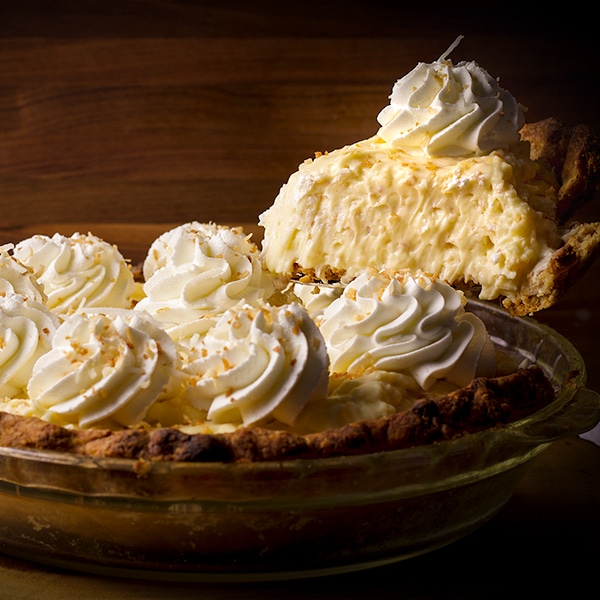
"I've been searching for the perfect pastry cream until I found your recipe! I made some cream pie yesterday, and making it as a filling was absolutely perfect! It's a must-try!" - Janice
Pastry Cream is a Building Block Recipe
Building block recipes are tried-and-true recipes that I consider foundational to great home baking. They are the kind of recipes I come back to over and over again, sometimes baking them as is, but often using them as a jumping off point to create something new. > Scroll through all Building Block recipes.

+ Subscribe to my newsletter for new and exclusive recipes in your in-box every month! As a full time traveler, living, working, cooking, and baking from a 5th wheel RV, it's also where I share our experiences of life on the road.
📖 Recipe
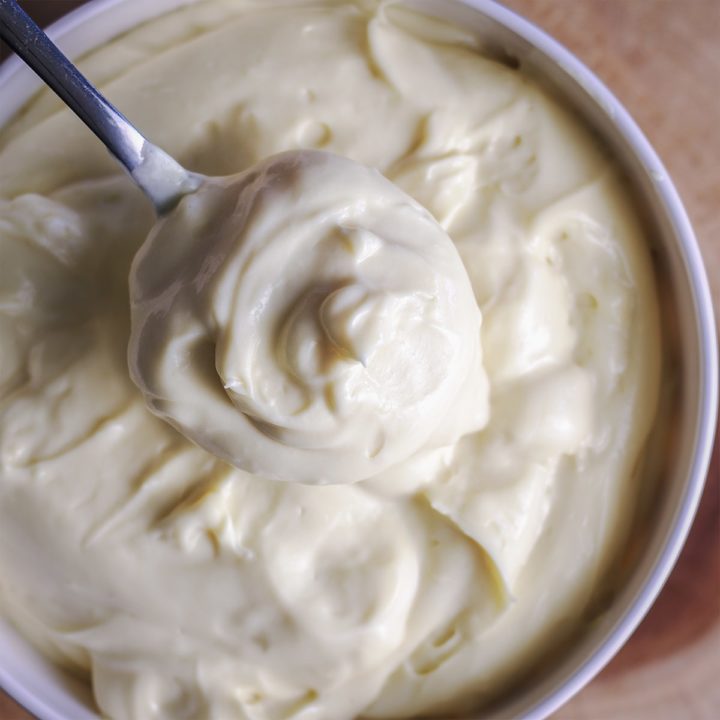
Best Pastry Cream Recipe
This is my absolute FAVORITE, tried and true recipe for silky smooth, perfect Vanilla Pastry Cream. It’s super simple, remarkably stable, and comes out perfect every time. It will hold its own at room temperature for hours without breaking down, bake it inside pastries like hand pies, and even freeze it.
Ingredients
- 1 ½ teaspoon (4.6g) unflavored gelatin
- 3 teaspoon (15ml) cold water
- 6 large egg yolks (*See note below for ideas about what to do with the egg whites.)
- ¼ cup (30g) cornstarch
- 2 cups (474ml) whole milk
- ½ cup (100g) granulated sugar
- ¼ teaspoon (1.5g) salt
- 2 teaspoon pure (9.8) vanilla extract
- ¾ cup (180ml) heavy whipping cream (*See note below if you are going to use this pastry cream in something that will be baked.)
Instructions
- In a small dish, stir the gelatin and water together to combine. There should be just enough water to moisten the gelatin, creating a rubbery paste. Set aside.
- Add the egg yolks and cornstarch to a medium size bowl and beat with a wire whisk to combine. Set the bowl on a kitchen towel somewhere close to the stovetop. (This will keep the bowl from sliding around on the counter when you whisk in the hot milk.)
- Set a 1 or 2 cup (240 - 480ml) heat proof measuring cup next to the stovetop, preferably one with a pourable spout.
- Add the milk, sugar, and salt to a 3-quart or larger heavy bottomed saucepan and stir to combine. Cook over medium heat, stirring frequently, just until it barely begins to boil. Remove the pan from the heat.
- Pour approximately 1 & ½ cups (360ml) of the hot milk into the glass measuring cup. Slowly pour the hot milk from the measuring cup into the egg yolks, pouring slowly, and whisking constantly. Then, pour everything back into the saucepan and set it over low heat. (You want to continue to heat the eggs slowly so they won’t scramble.)
- Cook, stirring constantly, until the custard is thick and begins to boil.
- As soon as thickens to the consistency of pudding and barely begins to boil, remove from the heat and whisk for about 20 seconds longer. Pour the pastry cream into a bowl.
- Break the gelatin into small pieces, dropping them onto the hot pastry cream. Let stand for about 20 seconds to let the gelatin to melt, then stir until the gelatin is completely incorporated. Stir in the vanilla.
- Cover with plastic wrap, pressing the wrap over the surface of the pastry cream. Refrigerate for at least 3 hours and up to 48 hours. (*At this point, the pastry cream can be frozen for up to 3 months.)
- Using an electric mixer, whip the heavy cream until stiff peaks form. (*See note below if you are going to use this pastry cream in something that will be baked.)
- Remove the cooled pastry cream from the refrigerator and add to the whipped cream. Beat on medium speed with an electric mixer to combine, about 1 minute. The pastry cream is now ready to use in any recipe.
Notes
- If you are going to use this pastry cream in something that will be baked, like this Strawberries and Cream Pie or Apple Hand Pies, DO NOT add the whipped cream.
- I like to stir the custard with a silicone spatula until the custard start to thicken so I can easily scrape along the corners of the pan. Once the custard begins to thicken, switch to a whisk and whisk vigorously.
- It's important to remove the pastry cream from the heat as soon as it thickens. This happens quickly; you'll be stirring and stirring, and the consistency will remain the same and then suddenly, it will thicken. When this begins to happen, whisk vigorously over the heat until the entire mixture is the consistency of pudding. Then remove it from the heat and continue to whisk for 20 seconds or so.
How to Freeze this Pastry Cream:
According to the entire internet, you cannot freeze pastry cream. But, friends, I am here to tell you that you CAN, in fact, freeze this pastry cream because of one superstar ingredient: gelatin.
Yes, the recipe also includes cornstarch and freezing things thickened with cornstarch generally results in a gloppy, gluey mess. But, simply add some gelatin and you can freeze the pastry cream with abandon. The consistency after it has thawed will still be perfectly creamy and delicious. It's magical.
- Freeze the filling BEFORE adding the whipped cream. Let the pastry cream cool in the refrigerator completely. Then, make sure it's in an air-tight container or a bowl that's well wrapped and put it in the freezer for up to 3 months.
- Allow the frozen pastry cream to thaw in the refrigerator overnight or at room temperature for about 3-4 hours. Once thawed, add the pastry cream to whipped cream as instructed in steps 10 and 11 of this recipe.
Recommended Products
As an Amazon Associate and member of other affiliate programs, I earn from qualifying purchases.
Nutrition Information:
Yield: 9 Serving Size: ⅓ cupAmount Per Serving: Calories: 215Total Fat: 13gSaturated Fat: 7gTrans Fat: 0gUnsaturated Fat: 5gCholesterol: 172mgSodium: 143mgCarbohydrates: 18gFiber: 0gSugar: 15gProtein: 7g


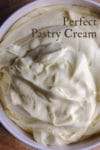
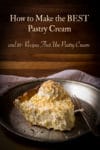
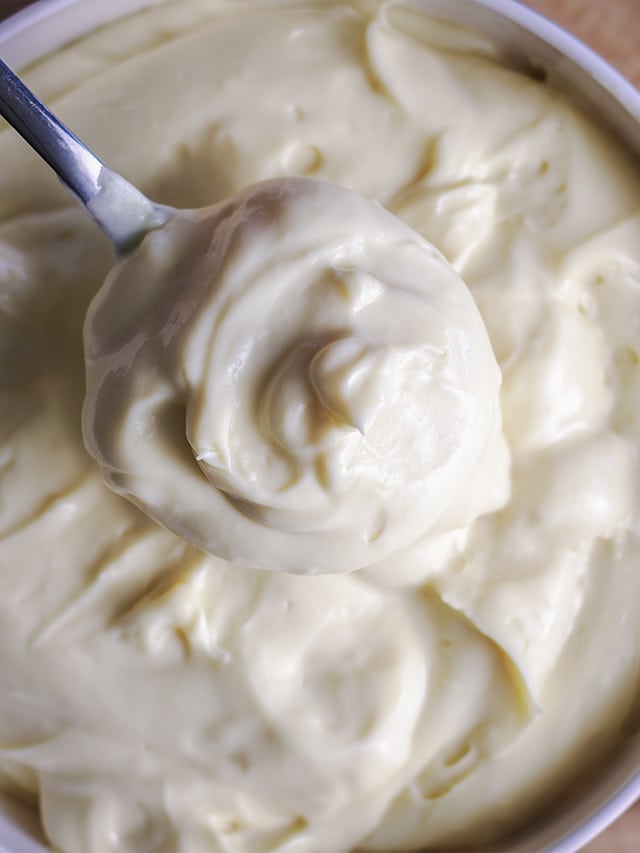





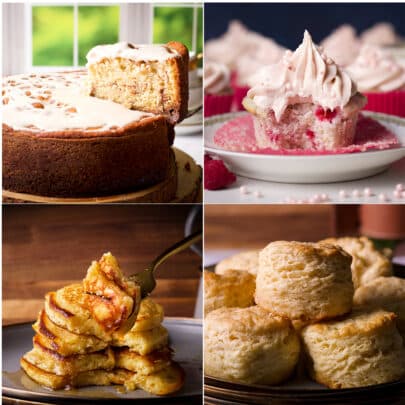
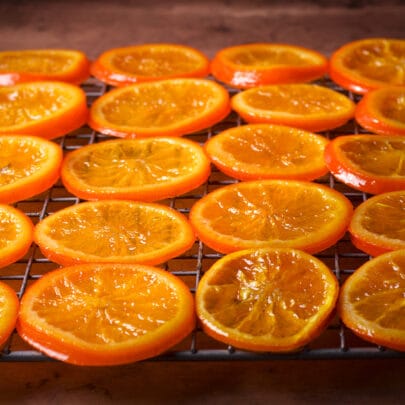
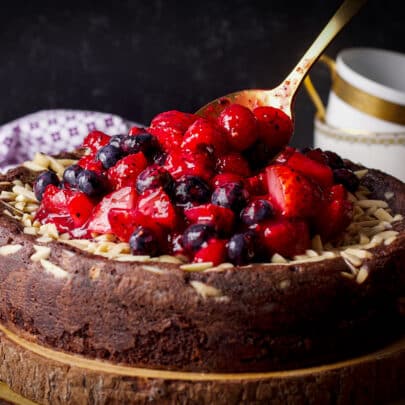
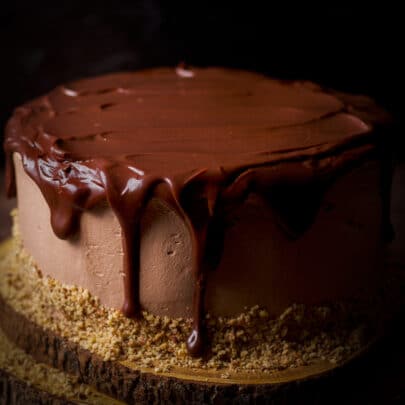
pearl says
Is there a way to make this dairy free? and is there a gelatin substitute?
Rebecca Blackwell says
Hi pearl! You can use any kind of dairy-free milk in place of the regular milk in this recipe. I've made this several times with full-fat coconut milk and it's absolutely delicious! But any kind of dairy-free milk will work. And, if you increase the amount of cornstarch to 1/4 cup plus 1 tablespoon, you can omit the gelatin entirely. Please not that the pastry cream cannot be frozen if made without gelatin, but other than that you shouldn't notice a difference. I hope that helps! Please let me know if you have any other questions!
Janice says
I've been searching for the perfect pastry cream until I found your recipe! I made some cream pie yesterday, and making it as a filling was absolutely perfect! It's a must-try!
Rebecca Blackwell says
I am so happy to hear that Janice! Thank you so much for taking the time to leave a comment for me! I truly appreciate it! xo
Jane says
I love how creamy and smooth this pastry cream is. It's incredibly rich, but not heavy.
Jen B says
First time making this - it never really thickened up pre-whipping cream. I'm chilling it now but it's still quite liquid and not pudding consistency. Is there any saving it?
Rebecca Blackwell says
Hi Jen! Sorry for the delayed response. Did you bring the custard to a boil while cooking it on the stovetop? By the time it reaches the boiling point, the cornstarch should cause it to thicken up substantially. Did that not happen for you?
Karen says
Would like to try this recipe using heavy cream instead of milk (that's what I have now in the fridge). Will that be a problem?
Rebecca Blackwell says
Hi Karen! Using heavy cream will work well - it will make for an especially rich and decadent pastry cream! I would suggest decreasing the amount of gelatin and cornstarch slightly to 1 teaspoon of gelatin and 3 tablespoons of cornstarch. The extra fat in the heavy cream will help to thicken and stabilize the pastry cream. Please let me know if you have any other questions! And, I'd love to hear how this pastry cream comes out for you! xo
debbie says
Hi! I am wondering if a larger fruit tart will slice well with the added gelatin? Usually fruit tarts are sort of gloppy when sliced 🙂
Thanks!
Rebecca Blackwell says
Hi Debbie! Yes! This pastry cream is perfect for sliceable tarts. The pastry cream is quite thick before adding the whipped cream (step #10). For sliceable tarts that will completely hold their shape, don't add the whipped cream at all. Or, just fold in a little bit of whipped cream, adding just enough to soften it slightly. I hope that helps! Please let me know if you have any other questions! And, if you use this in a tart, I'd love to hear how it works out for you! xo
Debbie says
Thank you SO MUCH for your quick response! I will, most certainly, report back!
Debbie says
Hi Rebecca - I made the pastry cream and because it was a bit too heavy for my tart, I risked adding some whipped cream to lighten it some (I stiffened the whipped cream with dry vanilla pudding mix so it's very stable). I added maybe a 1/4 cup once it was whipped.
It worked beautifully! Thank you so much for the recipe!
Rebecca Blackwell says
Perfect!!! Thanks so much for taking the time to let me know how this worked out for you! Now I really want to make a fruit tart! 🙂
Ray n says
Hello, Rebecca! Would you please advise if gelatin can be replaced with agar-agar, fish gelatin or something else? We don’t use bovine or pork one. If yes, what the proportions would be? Many thanks 🙏🏻
Rebecca Blackwell says
Good question Ray! I have never tried using agar-agar in place of gelatin in this recipe but in general, you should be able to substitute agar-agar for a bit less than half of the amount of gelatin in a recipe. However, because agar-agar tends to cause foods to set more firmly than gelatin, I'd use even less and try using a scant 1/2 teaspoon in this pastry cream. If you try it, would you let me know how it worked for you? I'd guess that other bakers will be interested in your experience!
Marie says
The custard set nicely in the fridge. The next day I added the ¾ cup whipped cream and poured in it the pie shell, topped with dr oetkers clear glazed strawberries. The following day the pastry cream was completely runny, although delicious. Served the tart with spoons in dessert bowls.
What did I do wrong?
Rebecca Blackwell says
Hi Marie! First of all, good for you for rolling with the punches and serving the tart in bowls. It can be so disappointing when things we plan to serve for guests don't turn out like we hoped they would, but I'm sure your guests were still happy to have a delicious tart-in-a-bowl. 🙂
As to what went wrong, my guess is that juice from the strawberries or the glaze the strawberries were coated in might have melted into the pastry cream. I haven't ever used Dr Oetkers glaze, so I did a little bit of research and the Dr Oetkers website suggests chilling a custard fruit tart that has been glazed for only an hour before serving. While they don't caution about keeping a glazed tart longer than an hour, my guess is that it's best to brush the glaze on a custard fruit fairly soon before you plan to serve it.
I hope that helps! But, please let me know if you have any other questions or if you think the problem might have originated for another reason. xo
Michele says
Can't even read the ingredients as ads are blocking the first 2 ingredients. Reloaded and scrolled down THREE times so it's definitely your website. Really bummed as this recipe sounded awesome, I guess I'll never know. 🤷♀️
Rebecca Blackwell says
Hi Michele! Well, this bums me out too, in a really big way. I am so sorry to hear that your experience on the site was so poor. There should absolute not ever be ads blocking the recipe, or any of the content on the page. I have reached out to the ad company I work with and sent them your exact words, and will do my absolute best to get to the bottom of the issue and get it resolved. Thank you so much for taking the time to leave a comment about this. Without your comment, I might not know there is an issue. In the meantime, I am going to send you an email with the recipe. Thanks again and my apologies! xo
Terry C says
Sure. I will definitely let you know. Serving this for a dinner party Thursday so I’ll be back in touch. Thanks so much for the quick response.
Terry C says
Hi, I’ve made this pastry cream before and it was wonderful. My husband just request egg nog cream. What do you think about substituting egg nog for the 2 cups milk? Thanks for your thoughts or suggestions for making this egg nog.
Rebecca Blackwell says
Hi there! I think substituting eggnog in this recipe is a fantastic idea! I do suggest cutting back the sugar slightly to account for the sugar that's in eggnog... maybe cut it back to 1/4 cup instead of the normal 1/2 cup. If you try this, would you let me know how it comes out for you?
Stacey says
Thank you for the recipe! OMG so good! I’m thinking of using it for different things and was wondering about replacing the vanilla with maybe bourbon and banana bits, or orange juice with orange zest or maple and bacon bits. If I do this should I leave out the vanilla or kinda do half vanilla and half other?
Thank you.
Rebecca Blackwell says
Hi Stacey! I'm so happy to hear that you like this recipe! Every time I make it I have to force myself not to eat it all before it makes it to it's intended use. 🙂 You can add whatever flavoring you like in there. Just add flavorings slowly, bit by bit, so you can monitor the consistency - especially when adding liquids. There's a whole list of other recipes that use this pastry cream right before the recipe. In most of those recipes, I've added things like rum, amaretto, toasted coconut, and mashed banana. The cream holds up quite well to all sorts of delicious additions! Most of the time, I leave the vanilla in because vanilla accentuates and compliments most other flavors. But, if you're in doubt, simply spoon out a bit of pastry cream into a small bowl and add touches of whatever you want to flavor it with so you can taste it in small batches before committing to flavoring the whole bowl.
By the way - stealing your idea to add maple syrup and bacon bits. I'm thinking that the next time I make Apple Fritters, I just might take them ALL the way over the top and spoon maple bacon pastry cream over them.
xo
Vineeta says
Hi! On the topic of flavors, what is the best way to add in a rich fruit flavor? Can you mix in fruit pulp or would it be better in a curd form? I am trying to find a good Mango cream and a passion fruit cream for a cream tart recipe. Appreciate your advice
Rebecca Blackwell says
Hi Vinetta! Good question... I think using a fruit curd or jam would be your best bet. But, in a tart, you could also layer the pastry cream with fresh fruit and/or jam or preserves in the tart shell to add extra fruit flavor. I hope that helps! Please let me know if you have any other questions! xo
Sarah Gonsalves says
Hi!!
I’m totally new to cooking and baking and I’ve been trying to do more of it. I’ve been wanting Napoleons for ages now, but they’re no where to be found around town. So, I figured I’d make some! I just finished making the cream and it’s sitting in the fridge. It has such an eggy smell to it. I feel like I’ve done something wrong. When I added the milk and egg yolk mixture back into the pan to thicken, it never boiled, but it did get thick. I noticed right before it got thick that the bottom of the pan had some small chunks. Did I ruin it? 😫
Rebecca Blackwell says
Hi Sarah! No worries... I'm sure the pastry cream perfectly fine. Just proceed with the recipe, whipping the cream and beating the pastry cream into the whipped cream. After you've done that, taste it. If you think it needs a more pronounced vanilla flavor, feel free to add more. Please let me know if you have any more questions! And, will you keep me posted about how your Napoleons come out? xo
Jason says
Hey Rebecca!
Thanks for the recipe! Just made my first batch to use in a Prinsesstarta cake and it looks delicious! It’s currently chilling in the fridge.
I wanted to point out that Step 7 says to whisk for 20 seconds after taking it off the heat, but Note 3 says to whisk for 20 minutes. I did 20 seconds and it looks pretty thick. Hoping that’s correct.
Thanks!
Rebecca Blackwell says
Hi Jason! Yikes! Thank you so much for catching that typo! 20 seconds is definitely the correct time. 20 minutes would just be... torturous. 😂 I had to look up a Prinsesstarta Cake because I wasn't sure what that was, and WOW! It's gorgeous! I would love to see a photo of the cake after you make it if you're willing to share! Tag @ofbatteranddough on instagram if you post one. Or, send it to rebecca@ofbatteranddough.com. Thank you, thank you! xo
Jason says
My Prinsesstarta Cake only lasted a few minutes before my friends devoured it, but I’ll be sure to get some photos and share next time I make it!
Rebecca Blackwell says
I'm so happy to hear that Jason! I would LOVE to see photos of the next one! Thank you so much for taking the time to let me know! xo
MomOf3 says
Hi. Love your site and your recipes. May I ask if it's a must for the pastry cream to be chilled first before use? I want to use it as frosting for a cake which needs to be left out of the ref for about 4 hours. Maybe add flavor to it: chocolate or caramel. Can I use fresh pastry cream cooled to room temp only, or should I chill pastry cream first then use it as frosting? Worried that if was already refrigerated to set, it'll have to stay refrigerated all the time thereafter.
Rebecca Blackwell says
Hi there! From most of what I've read, pastry cream can be left out at room temperature for 4 hours max. After that, you are running the risk of harmful bacteria growth. As with anything made from dairy and eggs, the less time it spends at room temperature, the better. I also feel that you can get away with leaving a cake that's filled with pastry cream - pastry cream in between the layers of a frosted cake - at room temperature longer than you can if you are using the pastry cream as a frosting. If a pastry cream filled cake is refrigerated, the pastry cream will take longer to come to room temperature. If the pastry cream is on the outside of the cake, it will of course, get warm much faster. Since the cake you are making needs to sit out for a few hours, I might suggest using pastry cream as the filling and frosting it with Italian Meringue Buttercream. If you chill the frosted cake for a few hours, it will be ok to let it sit at room temperature for 4 hours.
I hope that helps! Please let me know if you have any other questions!
xo
MomOf3 says
Thanks! Was planning on frosting and filling a cake with flavored pastry cream. Just not sure if I should pour it onto the cake while still warm and let it set while at room temp. If I chill first, the cream will not be as smooth anymore and was hoping to use it with pouring consistency but will still set thick. =(
Carla Luan says
I've been on the hunt for the perfect pastry cream and this is definitely it. I've tried three different recipes on three consecutive days and this is the winner! I put it in several types of pastries to try it. Thank you for such an outstanding recipe. Your pate choux recipe was great and easy to follow as well. I feel like I've found quite a treasure in your site.
Rebecca Blackwell says
Carla, your comment just made my whole day! I am so happy that you liked this recipe and the pate choux recipes so much! Please let me know if you ever have any questions or feedback about any of the recipes you find here. Thank you, thank you for taking the time to leave a comment for me. I truly appreciate it! xo
Carla Luan says
Oh, be careful what you wish for! I absolutely love to bake. In the past two weeks, I've made Cream Horns, Cream Puffs, Napoleons and Mini chocolate bundt cakes. I've given them to the neighbors, the painters working on our house, anyone I can think of. Your pastry cream definitely inspired me. I'd like to attempt some petit fours at Christmas so I'll need one for that with pourable fondant, too, Thanks again!
Ginny says
I have a quick question. I'm looking for a recipe that can be frozen, then thawed and used in a baked dessert, such as a hand pie. According to your recipe, this sounds like it should work perfectly. My question has to do with the cornstarch. I've been told that once a product containing corn starch has been frozen, it will break down upon thawing. Am I correct in reading your pastry cream can be frozen, thawed and then used in a baked dessert?
Rebecca Blackwell says
Hi Ginny! Yes! You can freeze this pastry cream! The entire internet will tell you that you can't freeze anything thickened with cornstarch. This is true UNLESS you add some gelatin. The gelatin stabilizes the pastry cream so that it freezes and thaws perfectly. It's kinda magical. 🙂 Freeze this pastry cream after it's been allowed to cool completely in the refrigerator for at least 3 hours and BEFORE you add the whipped cream. Let the pastry cream thaw overnight in the refrigerator or on the countertop at room temperature for about 3 hours. At this point you can go ahead and whip the cream and beat the pastry cream into it (steps 9 and 10). Please let me know if you have any other questions! And, I'd love to hear what you think of this pastry cream after you make it! xo
RICHARD YERMAN says
Hello Rebecca;
OK. Made the pastry cream today. While it was "thickened", and the heavy cream was whipped to med stiff peaks, the final custard was a bit runny when placed between the pastry layers. The photo shows the custard to be fairly firm and "pipable". Are you supposed to get the first custard step to be firm first? Or, when adding the whipped cream, whip again to make firmer?
Thx and regard, Richard Yerman, Fremont, CA
Rebecca Blackwell says
Hi Richard! This pastry cream should be firm enough to hold its own when added as a filling to all kinds of pastries and desserts. A couple of questions to try and figure out why yours was on the runny side... Did you refrigerate the custard for at least 3 hours before adding the whipped cream? Was the custard super thick before adding the whipped cream?
RICHARD YERMAN says
Hi Rebecca;
Refrigeration: Yes. At least 4 hrs.
Custard: Was pretty thick. I noticed that "curds" were starting to form in the sauce pan so I stopped heating over the flame, then stirred in the gelatin (used natural unflavored pectin). The gelatin was pasty using on 2 tsp water to the powder.
Seems like the initial custard has to be REALLY thick?
So? Can it be thickened now that it's finished? If not, will have to toss as it won't hold its shape in the pastry.
Thx - Richard
Rebecca Blackwell says
Thanks for the response Richard! I would try and beat it with an electric mixer for a few minutes and see if that helps. I'm not sure why adding the whipped cream thinned it out so much... but am thinking that beating it might solve the issue. Keep me posted?
RICHARD YERMAN says
Hi Rebecca;
I tried "whipping" the cream, but it didn't work. So, being so runny, I had to scrap it. Will try again and be sure the initial egg mixture is thick. Perhaps do over a double boiler setup works best? Low heat and slow to avoid "cooking / scrambling" the eggs? Pls advise. Thanks and regards, Richard
Rebecca Blackwell says
Thanks for the update, Richard. I'm so sorry to hear that you had to scrap the batch. It's so strange that it was so runny! I'm over here scratching my head. You could cook the pastry cream over a double boiler after adding the eggs, but getting it up to temperature so that it thickens will take quite a while. I've made this more times than I can count, and cooking it over low heat is always sufficient as long as you remove it from the heat as soon as it thickens up. You should see it thicken to the consistency of pudding. The odd thing about your pastry cream being runny is that you said it was quite thick before you added the cream... which makes me think that the runny nature of it had something to do with the whipping cream itself. I'm honestly not sure what the issue is because the gelatin should hold everything together no matter what. Like I said, I'm scratching my head. 😊 Please let me know how it comes out the next time you make it! I'm so curious to know if you have a different result! xo
Julie says
Thank you for the quick reply - I will definitely let you know!
Julie says
I would like to make your eclair recipe with coconut pastry cream filling. How can I change this pastry cream (which is excellent btw) into a perfect coconut flavor?
Rebecca Blackwell says
Hi Julie! I'd suggest using some coconut extract and perhaps stirring in some toasted shredded coconut. You have to be careful with the extract - add it slowly, tasting as you go. If you've never toasted shredded coconut, just dump some into a dry skillet and cook over medium heat until about 50% of the coconut is golden brown. If you keep cooking it much longer, the toasted pieces will start to burn. I think I'd also use sweetened shredded coconut. If you try this, will you let me know how it comes out for you? xo
Candace says
Hi there Rebecca! Made this yesterday and used for a fresh cherry tart. I have made other versions of this but yours is the best...the gelatin gives this what I call “the anti sog factor”. No soggy crust here. The bit of advice I would give is what you mentioned, med low heat, heat to high will either scramble or curdle your eggs. However if that happens, run thru a mesh strainer and you still should be good. Thanks.
Candace
Rebecca Blackwell says
Hi Candace! I am so happy to hear that you liked this recipe! I was just thinking the other day about using this pastry cream to make a cherry tart! Did you cook the cherries, or just set them over the pastry cream fresh? Thank you so much for taking the time to leave a comment for me and caution bakers to make sure to cook the cream slowly so the eggs don't curdle. I have had to run my pastry cream through a mesh strainer more than once because of my impatience. 🙂
xo
Candace says
I did slightly cook the fresh cherries first, and then let them cool. Thickened them a little with sauce made of H2O, sugar, cornstarch and Cherry Kirsch. Also used a short crust shell. I can’t believe how fast it went. Thanks again for the awesome recipe!
Yosola says
Hi, please what can I substitute for the heavy whipping cream in the recipe as it is not readily available where I am. Thanks for the lovely recipe
Rebecca Blackwell says
Hi Yosola! You can actually just leave the whipped cream out if you like. The whipped cream lightens the pastry cream a bit, giving it a fluffier texture. But, the pastry cream is delicious and completely useable in any recipe without it. Another option would be to whip some coconut cream and fold that in. If you have access to coconut cream, here's what you want to do: chill a can of coconut cream for at least 12 hours. Scoop the thick "cream" from the top of the can. There will be liquid at then bottom of the can; save it for another use, but don't use it here. Beat with an electric mixer just as you would whipped cream.
I hope that helps! Please let me know if you have any other questions! xo
Kathleen says
I made this pastry cream for my mum for Mother's Day, and used it to make a vanilla slice - it was AMAZING!! These are my notes on the recipe:
- I would like to try with a touch more gelatine next time I make it for a slice. Seeing as I doubled the recipe, I would try 4 teaspoons rather than 3
- I used thickened cream which I think is the equivalent of heavy cream in the US
- The custard boiled at around 80 degrees celsius
- As mentioned, I doubled the pastry cream recipe, used three sheet of puff pastry, and measured out about 800g of the finished pastry cream between each layer of pastry
- My slice came all the way up the sides of my 20cm x 20cm baking tin (which are about 8cm), and I had used baking paper and inverted slice out onto a plate. If you do this make sure your baking paper hangs over the edge of the tin so you can lift the tin off easily once you've inverted it
- I finished making slice on Saturday night and cut in the tin on Sunday afternoon before inverting, I think this helped because the pastry was more soggy a day later and easy to cut through
Kathleen says
Oh, and also, I sprinkled powdered gelatine over the water. When the gelatine stops soaking into the water I use a small spray bottle to spray the gelatine on top to make it moist.
Rebecca Blackwell says
Thank you so much Kathleen for taking the time to leave all this great information! I'm so happy this recipe worked out well - and am now dying to make a vanilla slice. I am so grateful for bakers like you who are so generous with your time and take the time to leave comments for others. Thank you, thank you! xo
Tzipi says
Hi - I would like to use this cream in a Napoleon cake. Can the Cream and cake be made a day in advance and fully assembled? Or it’s best to make cream the day before and assemble same day? Thank you
Rebecca Blackwell says
Hi there! The pastry cream can be made up to 3 days in advance. Just keep it in a covered container in the refrigerator. And most cakes and pastries can also be made a day or two in advance, but store them at room temperature, covered in a layer or two of plastic wrap. Please let me know if you have any other questions. And, I'd love to hear what you think of this recipe after you make it! xo
Vivian Chen says
Hi Rebecca, I made this pastry cream last night and it was a huge success! I did follow the tips about gelatin given in the commends. Hitting it up few secs in microwave made it completely dissolve. the pastry cream was fluffy, consistant and delicious! thanks for sharing your recipe. hope you have a wonderful day.
Rebecca Blackwell says
Hi Vivian! I am so happy to hear that you liked this recipe! You know, one of the things I love about publishing recipes online with space for readers to leave comments is that, over time, other bakers leave their tips and tricks, asking and answering questions, and all of that only makes a recipe better. As much as I will always love cookbooks, you just don't get that kind of interaction with them. Anyway, than you so much for taking the time to leave a comment. I appreciate it more than I can say! xo
Leslie says
Hello, Thank you for this recipe! About how long would you say it takes to do step #6? ("Cook, whisking constantly, until the custard is thick and begins to boil.") I found that it got super thick without ever boiling, so I eventually took it off the heat. But it was so thick already and didn't seem hot enough for the gelatin pieces to melt into it. Did I just not wait long enough? Or did I wait too long possibly? Thanks!
Rebecca Blackwell says
Hi Leslie! Thanks for reaching out. It's interesting that the custard thickened up for you so long before boiling. Every time I've made this, the custard begins to thicken right before it reaches the boiling point. Is there any chance you accidentally added less milk? Or extra cornstarch? Did you try to add the gelatin anyway? What happened after it cooled down? Did it retain its thickness? Sorry for asking you so many questions in response to yours! I'm just a bit perplexed and would love to understand more about what might be going on here. 🙂 xo
Leslie says
Hello!
I just tried this again, and yes, I must have added too much cornstarch or not enough milk the first time around. But I did not add the gelatin, and it was still delicious! I thought it came out perfectly.
This time around, the custard began to thicken right before it started to boil. I wish I knew what I did "wrong" the first time around haha.
Anyways, thank you - this really is amazingly delicious!
Rebecca Blackwell says
Hooray! I can't tell you how many times I've made things that haven't turned out right and never figured out the reason why. There are just too many factors involved to figure it out sometimes. Regardless, I'm super happy that you tried this again and that it worked out well for you this time! The gelatin is mostly in there to add some extra stabilization to the pastry cream. It helps it hold up better when used as a filling in cakes and pastries that might sit out at room temperature for a few hours before being served. It also makes it so that the pastry cream can be baked without curdling. But, as you've discovered, it's not 100% necessary. 🙂 THANK YOU so much for taking the time to let me know that this recipe worked out well for you. I appreciate it more than I can express! xo
Leslie says
Thank YOU for sharing your gifts and knowledge! I could seriously just eat it straight up. But definitely excited to try it in some pies, cakes and other pastries. It really is the perfect pastry cream!
Rebecca Blackwell says
Every time I make it for something I have SUCH a hard time not just eating it all straight from the bowl. 🙂 xo
Aleta says
Wow, what a great recipe! I can't believe that it can be left out of the fridge for hours, used as is or even baked inside desserts! Very cool. I think I'll be making some donuts for this delicious pastry cream!
Rebecca Blackwell says
Thank you so much Aleta! I can't think of a better excuse to make doughnuts! xo
Lauren Vavala says
Ohh this pastry cream is so, so good! I love the creamy vanilla flavor - definitely a go-to recipe now!
Rebecca Blackwell says
I am so happy to hear that you like this recipe Lauren! Thank you so much for taking the time to let me know! xo
Terri S says
How long can this pastry cream last at room temperature as a filling in a cake?
Rebecca Blackwell says
Hi Terri! There's a safe answer and a real life answer to this question. I'll give you both. 🙂 Pastry cream can be left out at room temperature for 4 hours without any worries about it not being safe to eat. Having said that, I've left cakes filled with pastry cream (and eclairs and profiteroles and doughnut holes) out for much longer than 4 hours with no ill effects or change in consistency. I think the main thing you want to pay attention to is the temperature of the room. If it's the middle of summer and a cake filled with pastry cream is sitting outside in the sun, you should probably eat it pretty quickly. If it's being held inside at somewhere around 70 degrees, you're probably fine for several hours.
Does that help? Please let me know if you have any other questions! And, I'd love to hear what you think of this pastry cream after you make it! xo
Deb Bohaboj says
Hi, just found your recipe and can't wait to try it. You state that a plus to adding gelatin is that you can freeze the pastry cream! How long can it stay in the freezer and is there any downside to the consistency of it when you take it out to use it?
Thanks!
Rebecca Blackwell says
Hi Deb! Yes - the gelatin stabilizes the pastry cream allowing it to be frozen. I've never frozen it for longer than a couple of weeks, but if it's in a sealed container, I'd think it would be ok for up to 6 weeks. I've never had this happen, but if the pastry cream splits after thawing, another baker told me that this works like a charm: Put the thawed pastry cream into a saucepan and heat it over the lowest possible heat, stirring constantly with a whisk. When the pastry cream is warm, heat 1 tbsp of whole milk in the microwave until very hot (about 15-20 seconds). Add the milk to the pastry cream, and keep whisking to incorporate. This should bring the pastry cream back together.
Like I said, I've never had any issues with the pastry cream splitting after it thaws, but I've spent enough time reading through baking forums to know it can happen. I can't wait to hear what you think of this recipe. I've made it hundreds of times and find it nearly indestructible and always delicious. 🙂 Please let me know if you have any other questions! xo
Jess Mckim says
Hello!, I am new In batter and dough but really like the approach you have to your recipes and I coincide with you in the IMBC (that is what brought me here) and bout pastry cream. I truly Enjoy your blog. So thank you for sharing knowledge. About this recipe, I wonder if this pastry cream is consistent?, I am about to do a layered cake but I have that concern, I bet it will be tasty.
Well, thank you!
Rebecca Blackwell says
Hi Jess! I am so glad you found me. 🙂 I'm not totally sure what you're asking... I'm not sure if consistent is the right word? But if you're thinking of using this as a filling for a layer cake, go for it! It will be delicious. I would probably not add the whipped cream at the end if making this as a layer cake filling. I think doing so will make the pastry cream too soft and it might run out the sides of the cake. Does that answer your question? xo
Jess Mckim says
Yes! 😀 Thank you for taking you time to answer me. yeah I meant to say firm.I will be also trying your vanilla cake. I like to bake this kind because It reminds me the cakes we do in mexico layered with pastry cream. I will let you know how that goes 😉 have a good day. See you!
alanna conlee says
thanks for the comments. The lumps were definately the gelatin and not eggs. I have made pastry cream successfully many times but never with gelatin so I wanted to try it. I will try Mary's tip.
Rebecca Blackwell says
Let me know if the tip from Mary makes a difference, Alanna. If it works for you, I'll add a note in the recipe about this. Thank you!
Kate Ma says
Do you mix the gelatin with 3 teaspoons or 3 tablespoons? I came across a similar problem, and thought maybe it needed more liquid to bloom in. Thanks!
Rebecca Blackwell says
Hi Kate! 3 tsp of water is all you need, although if you added a bit more I don't think it would hurt the pastry cream at all. 3 tsp is just enough to moisten all the powder and create a sort of gel that can be broken apart into the warm pastry cream. Does that answer your question?
Alanna Conlee says
Is there a secret to the gelatin? I broke it up small and put it in hot pastry cream and wisked like crazy but I still ended up with hundreds of little gelatin lumps in my pastry cream
Rebecca Blackwell says
Hmmm.... I'm not sure why that happened Alanna. Gelatin should dissolve pretty easily with heat. Perhaps the gelatin was old? Another option is that the tiny lumps weren't gelatin at all, but egg yolks that had scrambled slightly. This is easy to do - It's definitely happened to me! The trick to keeping the eggs from scrambling is to make sure to stir the pastry cream constantly while it cooks and to make sure the heat isn't to high - medium to medium low is as high as you want to go. As soon as the mixture begins to boil, cook stirring vigorously for only 30 seconds before removing from the heat and continuing to stir for at least another 30 seconds. If the yolks sit on the bottom of the pan they scramble really quickly. Does this help?
Mary says
what always works for me and indeed everyone ive exchanged cooking notes with is to mix gelatine in 2-3 tablespoons of tap water to form a thick jelly and microwave for 7-8 seconds on high. At this point it would have turned into a thin liquid and is easily incorporated into whatever you desire.
Rebecca Blackwell says
That's a great tip, Mary! Going to have to try that myself. Thank you!